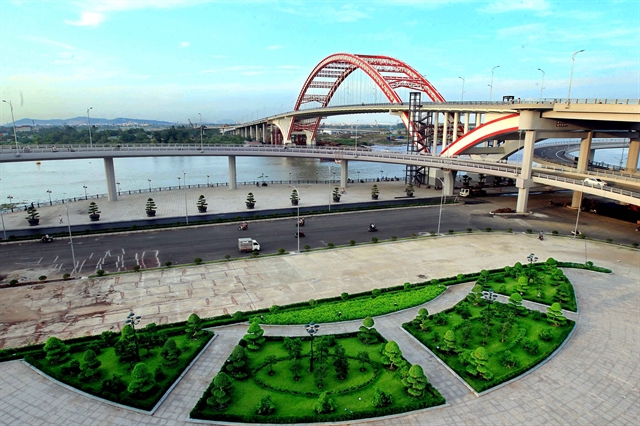 Society
Society

Connectivity and infrastructure are key elements to lower trade costs and help Việt Nam develop both global and domestic markets. But to achieve these goals, a new approach is needed for planning and investment strategies.

|
| Hoàng Văn Thụ Bridge, which is more than 1,570m long and 33.5m wide in Hải Phòng City’s Ngô Quyền District is key work to help the city expand to the north. Opening on October 15, last year, the VNĐ2.5 trillion (US$115.2 million) bridge connects the old inner city area with the future administrative area of Hải Phòng on the other side of Cấm River. — VNA/VNS Photo |
HÀ NỘI — Connectivity and infrastructure are key elements to lower trade costs and help Việt Nam develop both global and domestic markets.
But to achieve these goals, a new approach is needed for planning and investment strategies.
That was the message from the Việt Nam Development Report entitled 'Connecting Việt Nam for Growth and Shared Prosperity' which was launched on Wednesday by the World Bank with support from the Government of Australia.
“The rapidly changing patterns of international trade and domestic consumption coupled with increasing natural disaster risks will have implications on Việt Nam’s future connectivity needs,” said Ousmane Dione, World Bank Country Director for Việt Nam.
“Upgrading connectivity, not just physical infrastructure but also transportation and logistics services, with the right policies and investment will help Việt Nam go a long way towards achieving deeper integration, promoting inclusion and building resilience.”
Transport infrastructure developed unevenly across the country, the report found.
The country’s trade flows are concentrated at twelve of its 48 border gates – two airports, five seaports and five border crossing points – which handled 86 per cent of total trade value in 2016.
As trade grows, congestion around these international gateways and border crossing points has also increased, it said.
The movement of goods is mainly conducted on the road which carries three-quarters of total cargo volume.
To address the fragmented state of connectivity to better international trade, Dione suggested Việt Nam rationalise the use of existing transport infrastructure such as ports and promote multi-model transportation.
It was necessary to promote the alignment of transport and spatial planning to better support critical value chains, he said.
Dione also emphasised the need to invest in physical and digital infrastructure that maximise access to markets.
The report also sheds light how domestic transport and logistics systems are lagging behind increasingly sophisticated demands from middle-class consumers. As incomes rise, there is a change in consumption patterns.
However, the majority of consumers still prefer sourcing foods from traditional markets.
Increasing demand for fresh foods, combined with persistent traditional methods of moving and distributing produce, have resulted in significant food losses, unsafe foods, negative environmental impacts and public health threats, according to the report.
The rapid development of e-commerce also generated growing needs for new types of services including door-to-door connectivity and last-mile delivery, especially low-value and small-size parcels. This brought further challenges to Việt Nam’s already congested cities.
The report suggested measures including overhauling market infrastructure and logistics in cities and upgrading connectivity “software” to develop transport and logistics services to better integrate domestic markets.
Speaking at the event, Deputy Prime Minister Vương Đình Huệ appreciated the findings of the report, saying it comprehensively analysed economic impacts of connectivity on various aspects and losses that might occur in case of connectivity disruptions.
The report has provided noteworthy suggestions for Vietnamese researchers and policy makers, he said.
Việt Nam's open economy has brought about achievements in hunger eradication, poverty reduction and rapid growth. However, the country still faced great challenges in the context of trade liberalisation and unpredictable changes in global trade investment structure.
The Deputy Prime Minister said it was necessary to increase domestic investment and consumption instead of just focusing on international trade.
“Việt Nam can’t maintain export growth thanks to low value-added products,” Huệ said.
“It only took us two years to increase to US$100 billion in exports but the important issue is the added value and the localisation rate in imported and exported products.”
He proposed devising a strategy on infrastructure development, particularly basic transport infrastructure in harmony with the trade policy system, to develop a modern industrial economy.
Nguyễn Chí Dũng, Minister of Planning and Investment, said the report’s research would contribute more data for Việt Nam to complete the 10-year development strategy and five-year plan.
It also provided suggestions for building a master plan for the country over the next decade, he said. — VNS




